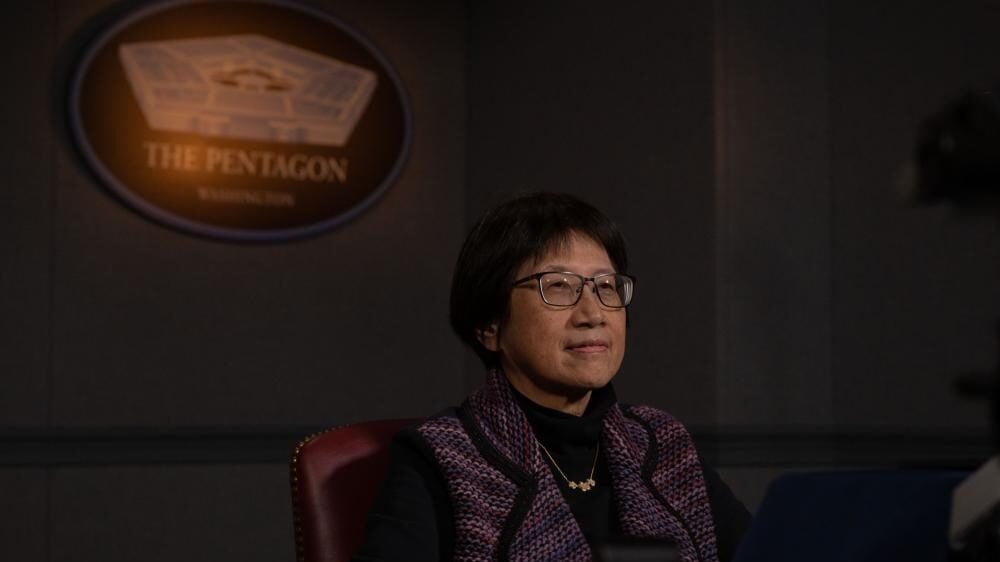
Under Secretary of Defense for Research and Engineering, Heidi Shyu speaks to Defense Writers via zoom at the Pentagon, Washington, D.C., Jan. 13, 2022. (DoD photo by United States Marine Corps Sgt. Taryn Sammet)
WASHINGTON — Lawmakers on the Hill are proposing major changes to the structure of a program used widely within the Defense Department to spur innovation, even as officials from DoD and industry are sounding the alarm that the US will lose ground to China in the competition over critical technologies if the program isn’t reauthorized by the end of next month.
According to correspondence between the Hill and the Pentagon obtained by Breaking Defense, even if the Small Business Administration’s (SBA) federal-funded Innovation Research (SBIR) and Technology Transfers (STTR) program is reauthorized in the short term, some lawmakers are looking at major changes to how the program is currently being run, in order to address concerns about whether taxpayers are being taken advantage of.
DoD is the primary user of the SBIR and STTR program, which was established in 1982 and is set to expire Sept. 30. The program has a total budget of over $3 billion.
SBIR includes three “phases,” with the first two being funded through the program. The third phase is where companies pursue commercialization of their technologies. According to SBIR.gov, at some federal agencies, phase three may involve follow-on non-SBIR/STTR funded research and development of production contracts for processes.
But between Phase II and Phase III is where companies fall into the dreaded valley of death, according to Kea Matory, director of legislative policy at the National Defense Industrial Association.
SBIR “Phase three is when you’re actually able to field it to the services, and there are times when a service may love what you have in phase two…the challenge is that they don’t have, for phase three…the rest of the technology,” Matory told Breaking Defense on Aug. 3.
The program has come under the microscope of lawmakers on both the House and Senate small business committees, according to legislative proposals on SBIR/STTR benchmarks shown in a July 12 response letter to the committees, obtained by Breaking Defense, from Heidi Shyu, undersecretary of research and engineering.
In the first proposal, the Senate Small Business Committee would restrict eligibility to the SBIR/STTR programs based on the total number of awards received from the inception of the program. The second proposal, also from the committee, would restrict eligibility to the programs based on the number of awards received over a five-year period.
In the third proposal, the House Small Business Committee restricts eligibility based on enhanced requirements associated with the existing Phase I to Phase II transition rate and the Phase III commercialization benchmarks.
In her response, Shyu expressed the benchmarking requirements present “significant concerns” for DoD and a program extension would be the preferred approach to fully assess potential program challenges.
Specifically, the first two proposals would have “drastic impact” on the program, with the second proposal being the most severe, impacting 95% of small businesses. The proposed benchmarks will also be resource-intensive and time-consuming for DoD, Shyu said.
“The Department, as well as the SBA and other agencies, respectfully disagree with the argument that multiple awards represent a significant problem and that having multiple awards ‘crowds out’ or limits competition,” Shyu said. “All SBIR/STTR awards are competitively awarded efforts with multiple awards addressing multiple topics. While a company can receive multiple awards, those awards are not for the same topic. In addition, the Department is concerned about the impact to the Department’s small business innovation base and its ability to meet warfighter needs if current SBIR/STTR projects are terminated due to benchmarks that go too far.”
She added DoD is also concerned about the additional technology infrastructure and staffing that will be necessary for the increased levels of reporting and oversight by the proposed benchmarks.
However, DoD “cautiously” recommended moving forward on a two-year pilot basis with the House Small Business Committee’s proposal because it would cause the least disruption to executing the SBIR/STTR program and is comparable to current benchmarks. The proposal would also allow a phased approach to implementing new benchmarks and allow time to understand the impact they’d have on small businesses, federal agencies and national security missions.
“The impact is more reasonable and allows for the Department to continue to invest in those riskier, challenging research and development activities and prototypes that DoD needs to test and learn from in order to advance mission-critical technologies,” according to the written responses. “The Department, working with SBA, has concluded that 10% of the small businesses would trigger limits associated with these benchmarks, all of which do business with DoD. Tier 2 Phase I to Phase II transition benchmark for firms with more than 50 awards would impact approximately 21 firms and the Tier 2 Commercialization benchmark for firms with more than 50 awards would impact approximately 152 firms.”
The programs’ reauthorization does not appear contingent on the committee and DoD coming to an agreement on the proposals, but they could later shape how the program operates for years to come.
Key Lawmaker Concerns About SBIR ‘Mills’
The most outspoken critic on the Hill is Sen. Rand Paul, R-Ky. As the ranking member of the Senate Small Business Committee, Paul is proposing reforms that would “curb abuse” from what are known as SBIR “mills” — a term given to a small group of companies who win many Phase I and Phase II awards but allegedly don’t actually do much actual commercialization and use the government funding as their primary revenue stream.
An aide for the senator told Breaking Defense the proposals include ensuring SBIR mills do not exist to solely profit off of government research and development grants without providing innovative technology or a return on investment to the taxpayer and expanding the SBIR award solicitation process, among other proposals. (Paul’s specific proposals are not included the letter Shyu sent to the House and Senate small business committees on their three benchmark proposals).
During a Sept. 22, 2021 Senate Small Business Committee hearing, Paul pointed to analysis he said showed that from 2009 to 2019, 21 percent of the awards were made to purported SBIR mills, which were defined in the analysis as firms who receive more than 40 phase one awards.
“The SBIR mills, the winners, will always ask to continue the flow of free money,” he said during the hearing. “It is somebody else’s money anyway. It’s the small businesses that are crowded out of this program that are not heard from, and the taxpayers, the people who pay all the costs while the others get the benefits. These people are the losers in this scheme. We need to question whether this program should continue to exist. We need to hold agencies accountable. And at the very least, we need to stop the abuse of the SBIR mills.”
A witness at the hearing, Jere Glover of the Small Business Technology Council, disagreed, saying, “every company knows that they have to have a commercialization component,” and suggested that at the time some 2,000 multiple award winning SBIR companies had been acquired by other firms because of the value of their technology.
DoD declined to comment on Paul’s claims about the SBIR mills and if they threaten the program.
One of Paul’s Democratic colleagues on the committee, Sen. Jeanne Shaheen of New Hampshire, told Breaking Defense she backs reauthorizing the program, saying it’s “a critical tool that empowers American small businesses with opportunities to play a role in support of US innovation.”
SBIR and the NDAA
Meanwhile, industry executives and officials within the Pentagon worry that the program won’t be reauthorized in this year’s yet-to-be-passed National Defense Authorization Act before it is set to expire.
“It is currently in the NDAA, however, given the challenges for the timeline for getting the NDAA across the finish line before the expiration of the program, we have serious concerns about what that is going to do to small businesses who are working in this space,” Matory said.
Likewise, in a statement to Breaking Defense, Shyu’s office said “failure to reauthorize the SBIR/STTR program could result in the DoD giving up its strategic advantage to China in the competition over critical technologies being cultivated in American small businesses and start-ups.
“Even if small businesses do not approach other countries for support, failure to reauthorize these programs risks these innovative small companies turning away from promising defense-relevant, dual-use technologies in favor of purely commercial technologies,” according to Shyu’s office.
Shyu, along with Bill LaPlante, undersecretary of defense for acquisition and sustainment, have expressed their concerns to lawmakers as well. In a June 3 letter sent to various House and Senate committees, first reported by Defense News, Shyu and LaPlante said a failure to reauthorize the programs would result in approximately 1,200 warfighter needs not being addressed.
“Our offices have been working to strengthen our partnerships with small businesses by streamlining the SBIR/STTR programs to make it easier for small businesses to work with the DoD and by fortifying security controls to ensure that SBIR/STTR-funded technology is not transferred to adversary nations,” according to the letter. “Without a program targeted towards small businesses, the Department will potentially lose access to the talent and innovation inherent in America’s small businesses. In addition, uncertainty in the program will discourage small companies from doing business with DoD in the future.”
While SBIR is important to bringing in small businesses to defense work, its continued funding is also critical in retaining work by the companies already contributing to DoD initiatives. Shyu and LaPlante in their letter expressed fear this could result in thousands of small businesses being forced to lay off workers or drive them to other sources of funding, including foreign investment.
Should the NDAA be delayed, another avenue for keeping the program alive is through a temporary funding measure called a continuing resolution, or a CR. How long it would be funded depends, since SBIR is not a specific line item in the budget itself and comes off of the top of the overarching budget, Matory said.
“If you look at the pie that is the entire DoD budget, [SBIR] is a tiny little sliver,” she said. “We’re talking in the 3% range. But it allows them to put it where they need when they see that we need innovation in this area and they’re able to put something out. So it has the flexibility that you don’t see in some of the other acquisition processes.”
Army’s chief data officer outlines plan for new hierarchy of ‘data stewards’
The service’s new policy empowers “mission area data officers” for warfighting, intelligence, business operations, and enterprise IT, as well as institutionalizing what have been “ad hoc” data duties across the service, David Markowitz told Breaking Defense.



























